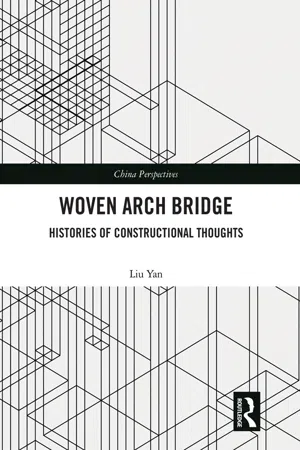
- 432 pages
- English
- ePUB (mobile friendly)
- Available on iOS & Android
About This Book
This book focuses on the woven arch bridge, an arch-shaped structure that is one of the most extraordinary timber building traditions of the world. The woven arch bridge exists widely in different cultures and its specific nature is conceptualized by the author as a kind of "universal uniqueness, " challenging widespread viewpoints on its origin and genealogy.
Taking this argument as its main thread, the book traces the histories of different woven-arch-bridge-cultures and investigates in particular the woven arch bridge in the mountains of Southeast of China from three angles, using both archaeological and anthropological methods. Resting upon these case studies, a definition of typology and a new theory of structural evolution are established, while the book also draws comparisons between western and eastern timber building cultures and offers new insights on the differences between East Asia and Europe.
The book also provides a large number of examples and illustrations of the bridge, and will be of great value and inspiration for architects and scholars studying the history of architecture, bridges, and construction, while also appealing to general readers interested in historical bridges and traditional construction technology.
Frequently asked questions
Information
1 From Caesar to Da Vinci
The woven structure’s Italian root
1.1Glory to Caesar!
1.1.1Caesar and his Rhine Bridge
Rationem pontis hanc instituit: tigna bina sesquipedalia paulum ab imo praeacuta dimensa ad altitudinem fluminis intervallo pedum duorum inter se iungebat. Haec cum machinationibus immissa in flumen defixerat festuculisque adegerat, non sublicae modo derecte ad perpendiculum, sed prone ac fastigate, ut secundum naturam fluminis procumberent, his item contraria duo ad eundem modum iuncta intervallo pedum quadragenum ab inferiore parte contra vim atque impetum fluminis conversa statuebat. Haec utraque insuper bipedalibus trabibus immissis, quantum eorum tignorum iunctura distabat, binis utrimque fibulis ab extrema parte distinebantur. Quibus disclusis atque in contrariam partem revinctis tanta erat operis firmitudo atque ea rerum natura, ut, quo maior vis aquae se incitavisset, hoc artius inligata tenerentur. Haec derecta materia iniecta contexebantur ac longuriis cratibusque consternebantur. Ac nihilo setius sublicae et ad inferiorem partem fluminis oblique agebantur, quae pro ariete subiectae et cum omni opere coniunctae vim fluminis exciperent, et aliae item supra pontem mediocri spatio ut si arborum trunci sive naves deciendi operis causa essent a barbaris missae, his defensoribus earum rerum vis minueretur neu ponti nocerent.(Caesar 1980, 195–8)
[He proceeded to construct a bridge on the following plan: He caused pairs of balks eighteen inches thick, sharpened a little way from the base and measured to suit the depths of the river, to be coupled together at an interval of two feet. These he lowered into the river by means of rafts, and set fast, and drove home by rammers; not, like piles, straight up and down, but leaning forward at a uniform slope, so that they inclined in the direction of the stream. Opposite to these, again, were planted two balks coupled in the same fashion, at a distance of forty feet from base to base of each pair, slanted against the force and onrush of the stream. These pairs of balks had two-foot transoms let into them atop, filling the interval at which they were coupled, and were kept apart by a pair of fibulis on the outer side at each end. So, as they were held apart and contrariwise clamped together, the stability of the structure was so great and its character such that, the greater the force and thrust of the water, the tighter were the balks held in lock. These trestles were interconnected by timber laid over at right angles, and floored with long poles and wattlework, And further, piles were driven in aslant on the side facing downstream, thrust out below like a buttress; and others likewise at a little distance above the bridge, so that if trunks of trees, or vessels, were launched by the natives to break down the structure, these fenders might lessen the force of such shocks, and prevent them from damaging the bridge.](Caesar 2006, 62)
Table of contents
- Cover
- Half Title
- Series Information
- Title Page
- Copyright Page
- Table of Contents
- List of Figures
- Introduction
- Part I Woven arch bridges: Three stories
- Part II Woven arch bridges in Southeast China
- Part III Conclusion
- Afterword
- List of referred historical MZ bridges
- Index